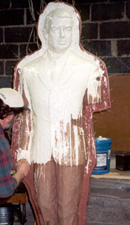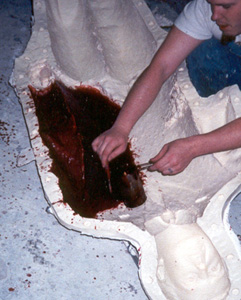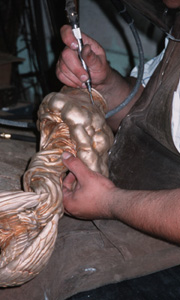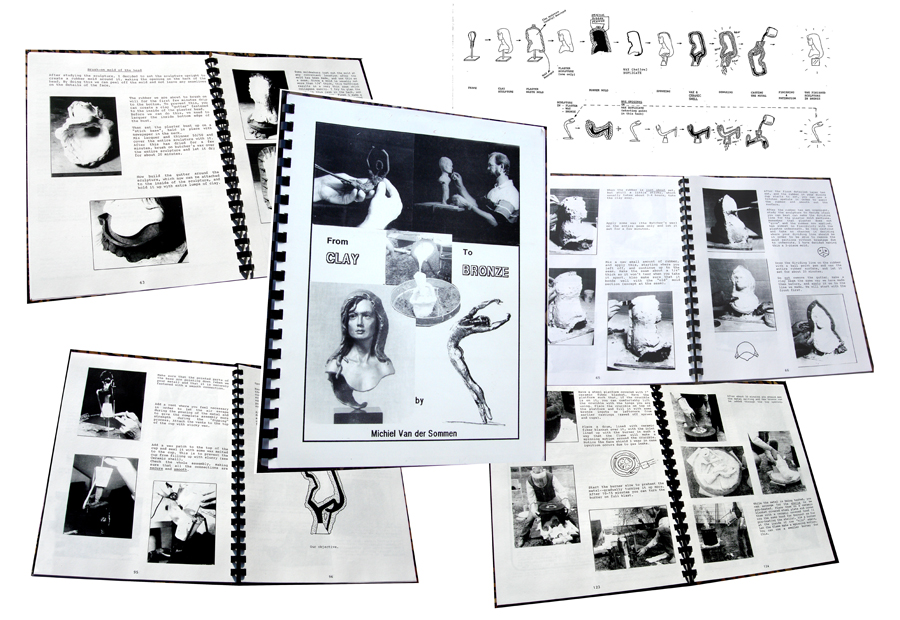Following is an explanation of how a bronze sculpture
is made, from the first model to the final mold to the finished piece.
 Making
the model. First, the artist sculpts a model in a wax-based clay.
This "original" of the artist's vision provides the basis for the mold.
Unlike a water-based clay sculpture, which
can be fired, keptand sold, wax-based clay is good for nothing except
sculpting. It has to be trans-ferred into another material tomake it
salable. Making
the model. First, the artist sculpts a model in a wax-based clay.
This "original" of the artist's vision provides the basis for the mold.
Unlike a water-based clay sculpture, which
can be fired, keptand sold, wax-based clay is good for nothing except
sculpting. It has to be trans-ferred into another material tomake it
salable.
Once the model is finished to the artist's satisfaction, it is taken
to a foundry  for a mold to be cast. for a mold to be cast.
Applying the rubber mold. At the foundry, liquid rubber is applied
to the surface of the clay model. The rubber is a very heavy product
in its liquid state and goes into every hole and crevice of the clay.
It is applied a few milimeters at a time. Once applied, it is allowed
to set overnight, then another small layer is ap-plied. This goes on
until you get the thickness you need, usually 3/16" to 1/4".It usually
takes about a week. Once it is dry, you have a flex-ible rubber mold."

Applying
the "mother" mold. Because the rubber mold is flexible, there needs
to be a hard back-ing to keep it in place. Therefore, the moldmakers
apply a plaster of Paris (or plastic) mold, called a "mother mold,"
on top of the rubber. Together, these two molds make up "the master
mold." After the plaster has hardened, the master mold is separated
along a designated line. (Sometimes moldmakers will place shims or pieces
of metal into the clay sculpture before the rubber and plaster molds
are applied to make the separation easier.) The model is removed from
the mold, and the inside of the mold is scraped clean. The original
clay model is usually completely destroyed in the process. 
Making a wax replica. The mother mold is put back together, and
liquid wax is poured into it. When the wax hardens, it forms an almost
exact duplicate of the origi-nal. However, the wax casting may not retain
every tiny detail of the original, requiring additional work by foundry
artisans.
Chasing the wax. After a wax replica is made, chasers then use
special tools on the wax replica to match the detail and texture of
the original model. The wax casting has to be completely perfect before
it goes to the next stage, because anything in the wax will come out
in the bronze. If the sculpture is to be produced in a limited edition,
a separate wax model is made for each piece in a limited edition and
is "chased" by hand. This  process creates a lim-ited edition of multiple
originals. process creates a lim-ited edition of multiple
originals.
Adding
gates and sprues. Next, wax tubes called gates and sprues are added to the wax replica. These tubes will
eventually form the conduits through which the wax will be "lost," and
they will assure that the bronze is evenly dis-tributed throughout the
mold.
Investing. The wax casting, with the gates and
sprues in place, now is dipped into a barrel containing a milky substance
called ceramic  slurry. After it is evenly coated with slurry, the casting
is sprinkled with silica sand. These colloids, or silica, are a kind
of glue to hold the shell together. The wax casting is dipped in slurry
and sand alternately slurry. After it is evenly coated with slurry, the casting
is sprinkled with silica sand. These colloids, or silica, are a kind
of glue to hold the shell together. The wax casting is dipped in slurry
and sand alternately  several times, over two or three days, to create
a ceramic mold, or "investment." The invest-ment is allowedto dry for
several days. several times, over two or three days, to create
a ceramic mold, or "investment." The invest-ment is allowedto dry for
several days.
Losing
the wax. The ceramic-covered wax casting is put into a burnout oven
or kiln for two to three hours at approximately 500 degrees Fahrenheit.
The wax melts and pours out of the ceramic gates and sprues-which were
formed in the mold around the wax casting-leaving an empty ceramic mold
to accept the melted bronze. Sometimes this wax is collected, or reclaimed,
to be filtered thoroughly and reused in another casting process.
  Pouring
the bronze. Once the wax has drained
completely, tech-nicians wearing heat-resistant suits and gloves remove
the ceramicmold from the oven and place it into a trough of sand. The
sand is there to support the invested piece,to keep it from tipping
over. Then bronze, heated to between 2,200 and 2,300 degrees Fahrenheit,
is poured into the mold. This is the stage where, if things are going
to go awry, they usually do. If there is a crack in one of the ceramic
molds, the bronze will run out. Workers are nearby with water pistols
to spray a crack if they see one, to stop the crack from forming and
salvage the mold. Pouring
the bronze. Once the wax has drained
completely, tech-nicians wearing heat-resistant suits and gloves remove
the ceramicmold from the oven and place it into a trough of sand. The
sand is there to support the invested piece,to keep it from tipping
over. Then bronze, heated to between 2,200 and 2,300 degrees Fahrenheit,
is poured into the mold. This is the stage where, if things are going
to go awry, they usually do. If there is a crack in one of the ceramic
molds, the bronze will run out. Workers are nearby with water pistols
to spray a crack if they see one, to stop the crack from forming and
salvage the mold.

Chasing the bronze. After the bronze cools, the ceramic mold
is re-moved from the bronze casting with chisels and hammers. The raw
casting still has the gates and sprues-now made of bronze-attached.
Bronze chasers remove the gates and sprues, as well as the scars this
removal leaves behind. Any bubbles, marks or other imperfections that
came through during the casting are also filled in and touched up. After
the sculpture is chased, it is sandblasted to remove all particles and
residue from the surface so that the patina chemicals will stick.
Applying the patina. A patina, a chemical that colors the  surface
of a bronze sculpture, can be applied to the surface by brushing or
spraying it on, or by burying the sculpture in a chemical-soaked textured
substance such as sawdust or dirt. There are various kinds of patinas
that give you different colors, hues and shades. Patinas can be as various
as red, green, white or gold, depending on the chemical used. Common
patina chemicals include salts, ammonias, nitrites, even urine (which,
early patiners discovered, turns the bronze "the most beautiful emerald
green). The patina both adds color and provides a protective layer to
the bronze to prevent it from oxidizing. While some artists do the patina
themselves, many hire profes-sional patiners, who experiment with a
large number of chemicals and mixtures to make various patina "recipes." surface
of a bronze sculpture, can be applied to the surface by brushing or
spraying it on, or by burying the sculpture in a chemical-soaked textured
substance such as sawdust or dirt. There are various kinds of patinas
that give you different colors, hues and shades. Patinas can be as various
as red, green, white or gold, depending on the chemical used. Common
patina chemicals include salts, ammonias, nitrites, even urine (which,
early patiners discovered, turns the bronze "the most beautiful emerald
green). The patina both adds color and provides a protective layer to
the bronze to prevent it from oxidizing. While some artists do the patina
themselves, many hire profes-sional patiners, who experiment with a
large number of chemicals and mixtures to make various patina "recipes."
Adding the final touches. If the sculpture is very large (called
monumental or heroic sculpture), or if it is very complex, it usually
is cast as separate pieces that can be handled easily. If so, at this
point, the pieces will be welded together or taken and assembled at
the intended site. The piece is then polished and mounted.
 Maintenance.Even though bronze sculpture is
easy to maintain, it is not maintenance-free. "As long as a sculpture
is cleaned and waxed twice a year, it will retain its patina forever,
but if a piece is not maintained, especially if it's handled, the patina
will begin to rub off and expose the bare bronze. A green oxi-dation
will start growing. Some people like that look, but the original patina
should be preserved. Maintenance.Even though bronze sculpture is
easy to maintain, it is not maintenance-free. "As long as a sculpture
is cleaned and waxed twice a year, it will retain its patina forever,
but if a piece is not maintained, especially if it's handled, the patina
will begin to rub off and expose the bare bronze. A green oxi-dation
will start growing. Some people like that look, but the original patina
should be preserved.
Many years ago I built a foundry to cast my own sculptures. In order to learn the many techniques of the sculpture and bronze casting process I developed a manual for myself and for my students at workshops. The manual is not for sale in stores, but if you would like a copy, please contact me.
(c) 1999 Michiel Van der Sommen
|

 Making
the model. First, the artist sculpts a model in a wax-based clay.
This "original" of the artist's vision provides the basis for the mold.
Unlike a water-based clay sculpture, which
can be fired, keptand sold, wax-based clay is good for nothing except
sculpting. It has to be trans-ferred into another material tomake it
salable.
Making
the model. First, the artist sculpts a model in a wax-based clay.
This "original" of the artist's vision provides the basis for the mold.
Unlike a water-based clay sculpture, which
can be fired, keptand sold, wax-based clay is good for nothing except
sculpting. It has to be trans-ferred into another material tomake it
salable.  for a mold to be cast.
for a mold to be cast.

 process creates a lim-ited edition of multiple
originals.
process creates a lim-ited edition of multiple
originals.
 slurry. After it is evenly coated with slurry, the casting
is sprinkled with silica sand. These colloids, or silica, are a kind
of glue to hold the shell together. The wax casting is dipped in slurry
and sand alternately
slurry. After it is evenly coated with slurry, the casting
is sprinkled with silica sand. These colloids, or silica, are a kind
of glue to hold the shell together. The wax casting is dipped in slurry
and sand alternately  several times, over two or three days, to create
a ceramic mold, or "investment." The invest-ment is allowedto dry for
several days.
several times, over two or three days, to create
a ceramic mold, or "investment." The invest-ment is allowedto dry for
several days.
 Pouring
the bronze. Once the wax has drained
completely, tech-nicians wearing heat-resistant suits and gloves remove
the ceramicmold from the oven and place it into a trough of sand. The
sand is there to support the invested piece,to keep it from tipping
over. Then bronze, heated to between 2,200 and 2,300 degrees Fahrenheit,
is poured into the mold. This is the stage where, if things are going
to go awry, they usually do. If there is a crack in one of the ceramic
molds, the bronze will run out. Workers are nearby with water pistols
to spray a crack if they see one, to stop the crack from forming and
salvage the mold.
Pouring
the bronze. Once the wax has drained
completely, tech-nicians wearing heat-resistant suits and gloves remove
the ceramicmold from the oven and place it into a trough of sand. The
sand is there to support the invested piece,to keep it from tipping
over. Then bronze, heated to between 2,200 and 2,300 degrees Fahrenheit,
is poured into the mold. This is the stage where, if things are going
to go awry, they usually do. If there is a crack in one of the ceramic
molds, the bronze will run out. Workers are nearby with water pistols
to spray a crack if they see one, to stop the crack from forming and
salvage the mold. 
 surface
of a bronze sculpture, can be applied to the surface by brushing or
spraying it on, or by burying the sculpture in a chemical-soaked textured
substance such as sawdust or dirt. There are various kinds of patinas
that give you different colors, hues and shades. Patinas can be as various
as red, green, white or gold, depending on the chemical used. Common
patina chemicals include salts, ammonias, nitrites, even urine (which,
early patiners discovered, turns the bronze "the most beautiful emerald
green). The patina both adds color and provides a protective layer to
the bronze to prevent it from oxidizing. While some artists do the patina
themselves, many hire profes-sional patiners, who experiment with a
large number of chemicals and mixtures to make various patina "recipes."
surface
of a bronze sculpture, can be applied to the surface by brushing or
spraying it on, or by burying the sculpture in a chemical-soaked textured
substance such as sawdust or dirt. There are various kinds of patinas
that give you different colors, hues and shades. Patinas can be as various
as red, green, white or gold, depending on the chemical used. Common
patina chemicals include salts, ammonias, nitrites, even urine (which,
early patiners discovered, turns the bronze "the most beautiful emerald
green). The patina both adds color and provides a protective layer to
the bronze to prevent it from oxidizing. While some artists do the patina
themselves, many hire profes-sional patiners, who experiment with a
large number of chemicals and mixtures to make various patina "recipes."  Maintenance.Even though bronze sculpture is
easy to maintain, it is not maintenance-free. "As long as a sculpture
is cleaned and waxed twice a year, it will retain its patina forever,
but if a piece is not maintained, especially if it's handled, the patina
will begin to rub off and expose the bare bronze. A green oxi-dation
will start growing. Some people like that look, but the original patina
should be preserved.
Maintenance.Even though bronze sculpture is
easy to maintain, it is not maintenance-free. "As long as a sculpture
is cleaned and waxed twice a year, it will retain its patina forever,
but if a piece is not maintained, especially if it's handled, the patina
will begin to rub off and expose the bare bronze. A green oxi-dation
will start growing. Some people like that look, but the original patina
should be preserved.